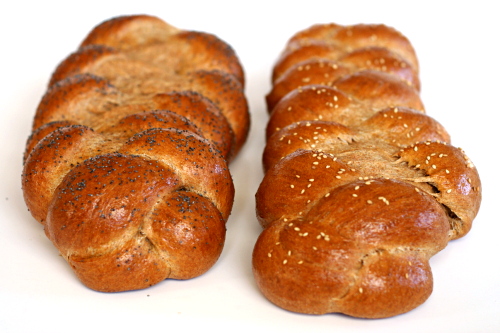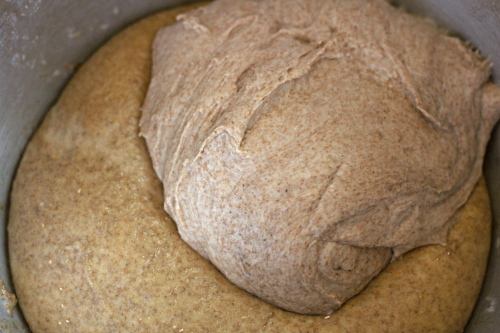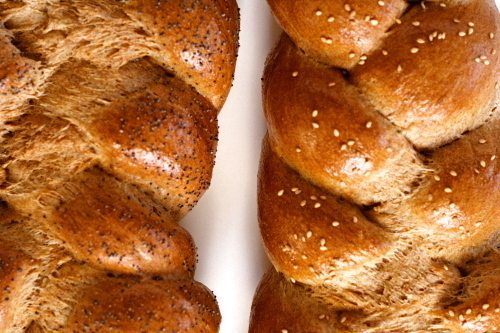This is the third or fourth challah recipe I’ve tried and most certainly my favorite. Yes, the whole wheat version is the best challah I’ve made. I’m surprised too.
Maybe challah doesn’t seem like something that would adapt well to whole wheat? Whole wheat bread is often denser and drier than refined flour loaves, and challah should be light and fluffy and tender. Peter Reinhart knows this; you must trust Peter Reinhart.
He uses his standard whole wheat trick of soaking the whole wheat flour overnight to break down the grains. In this case, one of the pre-doughs uses eggs instead of water as the soaking liquid. He uses oil instead of the butter many recipes require. Everyone loves the taste of butter, but I’m becoming more and more enamored with oil in baking, because it makes things so tender and moist.
I really don’t think I like whole wheat bread any more than the average person. I think it’s just that, using Reinhart’s recipes, I can make some exceptionally good whole wheat bread. This is perfect challah whether you’re a white bread or a wheat bread lover.
One year ago: Lemon Meringue Cake
Two years ago: Fried Egg and Sausage Ciabatta Breakfast Pizzas
Printer Friendly Recipe
Whole Wheat Challah (adapted slightly from Peter Reinhart’s Whole Grain Breads)
You can do more complicated braids with this if you prefer. Just do an internet search for instructions for 4-, 5-, and 6-strand braids.
Soaker:
1¾ cups (8 ounces) whole wheat flour, preferably fine grind
½ teaspoon salt
¾ cup water
Biga:
1¾ cups (8 ounces) whole wheat flour, preferably fine grind
¼ teaspoon instant yeast
½ cup water
2 tablespoons vegetable oil
1 large egg
4 large egg yolks
Final dough:
the soaker
the biga
7 tablespoons (2 ounces) whole wheat flour, plus more for adjustments
¾ teaspoon salt
2¼ teaspoons instant yeast
2 tablespoons sugar or brown sugar, or 1½ tablespoons honey or agave nectar
2 tablespoons vegetable oil
Toppings:
1 egg
1 tablespoon water
pinch salt
poppy seeds or sesame seeds (optional)
1. For the soaker: In a medium mixing bowl, mix all of the ingredients together. Cover and leave at room temperature for 12 to 24 hours, or refrigerate for up to 3 days. If the dough is refrigerated, leave it at room temperature for 2 hours before mixing the final dough.
2. For the biga: In a medium mixing bowl, mix all of the ingredients together. Knead for 2 minutes; the dough will feel very tacky. Let the dough rest for 5 minutes, then knead for 1 minute. Cover and refrigerate for at least 8 hours and up to 3 days. Leave it at room temperature for 2 hours before mixing the final dough.
3. For the final dough: Cut the soaker and biga into about 12 smaller pieces. Put the pieces in the bowl of a standing mixer fitted with the dough hook along with the 7 tablespoons flour, the salt, instant yeast, sugar, and oil. (Or mix by hand in a large bowl.) Mix on slow speed for about 1 minute, until the dough comes together, then increase the speed to medium-high and continue mixing and kneading for 6 minutes, adding flour if necessary, until the dough is soft and tacky, but not sticky. (Or knead by hand for 6-8 minutes.) Let the dough rest for 5 minutes, then resume kneading for 1 minute. Form the dough into a ball and place it in a greased bowl. Cover and let rise at room temperature for 45 to 60 minutes, until it is about 1½ times its original size.
4. Gently transfer the dough to a lightly floured work surface. Divide the dough into 6 evenly sized pieces for 2 smaller loaves or 3 evenly sized pieces for 1 large loaf. Roll each portion of dough into a rope about 10 inches long, letting the dough rest for 5 minutes if it’s very elastic. Braid the ropes.
5. Place the braid(s) on a sheet pan lined with parchment paper or a silicone mat. To make the egg wash, whisk the egg, water, and salt (listed above in Toppings) together. Brush the braids with the egg wash, cover, and let rise at room temperature for 30 minutes.
6. Brush the dough with the egg wash again, then top with poppy seeds or sesame seeds, if using. Leave the dough uncovered and let rise for 15 more minutes. Preheat the oven to 400 degrees.
7. Place the challah on the middle shelf, reduce the heat to 325 degrees, and bake for 20 minutes. Rotate the loaf 180 degrees and bake for another 20 minutes. Check the bread and rotate again if it is baking unevenly. Continue baking for an additional 10 to 15 minutes, until the bread is a rich brown all around, sounds hollow when thumped on the bottom, and registers at least 195 degrees at the center.
8. Transfer the bread to a cooling rack and let it cool for at least 1 hour before serving.












A recipe that makes whole wheat tasty? Count me in!
Wei-Wei
Yep, that man definitely has a clue when it comes to whole wheat. I adore challah, but I have a favorite recipe… I think this requires a recipe smackdown, very soon 🙂
(Oh, and ciabatta, not ciabbata)
(After second guessing myself, both spellings look wrong. Guh, I hate when that happens 😛 )
Those loaves are beautiful! This reminds me I STILL haven’t tried the pre-dough method, even though I’ve been meaning too for months. I need to try this!
I think you’ve tried more challah recipes than this Jew! And I’ve certainly never tried a wheat challah. I’ll say that I’m surprised you’re finding a lot of recipes calling for butter. I think a true challah should be made with oil. Challah made with butter could not be served with a meat meal, but challah made with oil can be served with either meat or dairy.
pretty, pretty!
If it tastes anywhere near as good as it looks I bet it’s amazing! I love challah and am glad there’s a whole wheat recipe out there that isn’t super heavy…when I’m feeling patient some day I’m going to try this! 🙂
Did you use hard white wheat or hard red? Combo? Looks so good and is a family fav!
gosh, you make a pretty challah! i think i do like wheat bread more than the average person, so i would love this!
I am making your whole wheat challah, but noticed there is no specific temperature for the water. Please tell me about this. I can’t wait to make it.
Ellen – I use room temperature water. Cold or warm water is fine, as long as it isn’t too hot (I wouldn’t go higher than 100 degrees) to kill the yeast.
After reading this entry, I started making the dough immediately. Unfortunately it didn’t taste as good as it looked :(. That may be because I am not used to homade wheat bread, or it may have been because I had never had challa bread before, but in any case it wasn’t worth the effort in the end (roughly 16 hours later). It looked great though.
This looks fabulous! I just made my first loaf of brioche and was pretty sure that I’d never find a good way to make it healthy. I am definitely up for this challenge though!
Question: is whole wheat fine grind flour the same as whole wheat pastry flour?
I just wanted to leave a comment here to say that I made this and I loved it! I’ve tried about 2 other whole wheat challah recipes before and wasn’t too happy with them, but this one worked really well. 🙂 Thanks for the recipe! I need to check out Reinhart’s book….
PS. For those wondering about the flour, I just used whole wheat pastry flour. I wouldn’t recommend just using “regular” whole wheat flour — that comes out a little too dense and wheat-y.